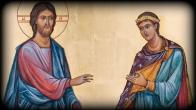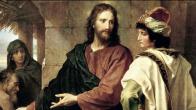You are here
St. Athanasia, Abbess of Egina
12/25 April
Saint Athanasia was the abbess of a convent on the island of Ægina. She was born of the spouses, Nikita and Marina, in a pious Christian family. Already at seven years of age, the girl had learned the Psalter, which she read constantly with compunction. Once, while working at a loom, Saint Athanasia saw a shining star descending to her from above, which, having come down to her breast and illumined her entirely, vanished. From that time, the maiden was enlightened in soul and firmly decided to go to a convent.
When Saint Athanasia was sixteen years old, her parents besought her to marry. The girl submitted, but in all spent only sixteen days in marriage: her husband was taken to war and killed there.
Having been widowed, Saint Athanasia decided to fulfill her long-standing desire. But at that time an edict came from Emperor Michael the Stammerer (820-829), according to which young widows had to enter into marriage with young warriors. Saint Athanasia had to marry again: she labored in housework, helped the sick and needy, received strangers. On Sundays, the Venerable one would invite relatives and acquaintances to her home and would read Sacred Scripture to them. Under her influence, her husband retired to a monastery and gave his wife permission to be tonsured.
The Saint distributed her property, accepted monasticism and withdrew together with reverent women to a solitary place. After some time, the sisters besought Venerable Athanasia to become the abbess of their small community. The Saint looked upon her abbacy as a special ministry to God and the sisters. She gave an example of meekness and humility. She corrected all the faults of the sisters with love and without anger.
Although Saint Athanasia bore the title of abbess, she considered herself the last among the sisters and would always remember the Saviour's commandment: "Whosoever will be chief among you, let him be your servant" (Matthew 20:27). The Venerable one never permitted the sisters to serve her, even if only to pour water on her hands.
Venerable Athanasia wore a hair shirt, while on top of it she wore clothing of coarse sheep's wool; she would sleep little and would pray the greater part of the night. By day, she would work together with the sisters. She would take food, which consisted of a piece of bread and water, only in the evening. She permitted herself oil, cheese and fish only on the Nativity of Christ and Holy Pascha. During the fasts, she would feed only on raw greens once in two days. Venerable Athanasia spent four years in this monastery.
On the island of Ægina lived a monk-elder, Venerable Matthew, who had formerly been an abbot. He took upon himself a great ascesis: each night he would read through the Psalter, joining prayers to the reading as well. The saint would sleep sitting and for a very little time. During the singing of the psalms, the reading of prayers and the offering of the Bloodless Sacrifice, the Venerable one could not refrain from tears. He wore only a rough hair shirt and, by great abstinence and struggles, had completely withered his flesh. He had a special love for Saint John the Theologian. Once, during the performance of the Divine Liturgy, he was counted worthy of seeing the Apostle standing on the Holy Table. With his mantia, the Venerable one healed a paralytic; by the sign of the Cross, he set right a man's face that had been distorted by the action of the devil; he expelled demons and worked many other miracles Venerable Matthew blessed Saint Athanasia to depart with her sisters to an even more solitary place. On the same island, she established a monastery on a desert mountain close by the ancient church of the Protomartyr Stephen.
Venerable Athanasia was counted worthy of the gift of healing from God. After she had healed a man whose eyes were ailing, a multitude of people began to stream to her in order to receive healing from infirmities of soul and body. With the abundant offerings of those who came to the monastery, the Venerable one built three churches in the monastery: in the name of the Most Holy Theotokos, in the name of the Holy Prophet John the Forerunner and in the name of Hierarch Nicholas the Wonder-worker.
Her fame, which had become so widespread, weighed heavily upon the Venerable one, and she took two sisters close to her in spirit (Maria and Eupraxia), and departed secretly for Constantinople. There, as a simple nun, the Venerable one entered one of the monasteries, where she lived for seven years.
But her holy life again attracted attention. The sisters of the Ægina monastery learned wither their abbess had gone, and they went to her, beseeching her to return. Submitting to God's Providence, the Venerable one returned to the monastery founded by her. Soon after that, she was counted worthy of seeing two radiant men, who gave her a parchment with the words: "Here is thy freedom; take it and be glad".
For twelve days before her end, Venerable Athanasia remained in unceasing prayer. On the eve of the feast of the Dormition of the Most Holy Theotokos, she summoned the sisters and said that she had been able to read the Psalter only to the Nineteenth Psalm. The Saint asked them to finish reading the Psalter to the end for her in church. The sisters went to church and there fulfilled her request, and afterwards they came to bid farewell to the Venerable one. She blessed them and asked them to conduct the feast of the Dormition of the Theotokos solemnly and joyfully and to arrange a meal for the beggars and paupers, and to commit her body to burial after the Divine Liturgy. With these words, Venerable Athanasia departed to the Lord (+14 August 860).
At the Divine Liturgy on the fortieth day, two pious sisters were counted worthy of seeing how Saint Athanasia appeared before the royal gates. Two radiant men adorned her head with a crown with crosses, handed her a brilliant staff and led her through the royal gates into the altar.
Before her death, Saint Athanasia had left a testament that the poor be fed in her memory until the fortieth day. The sisters, however, did not fulfill her testament and set up a memorial trapeza for only nine days. The Saint appeared to certain sisters and said: "It was wrong that you did not fulfill my testament - the forty-day commemoration in church of those who have fallen asleep and the feeding of the poor greatly helps sinful souls, while heavenly mercy is sent down from righteous souls to those who carry out the commemoration." Having appeared, she drove her staff into the ground and became invisible. The next day, the staff that had been left behind sprouted and became a living sapling. A year after the death of the Venerable one, a possessed woman was brought to her grave. When they dug up the earth, they sensed a fragrance and took out the coffin. Having touched it, the possessed woman was healed at once. They then opened the lid of the coffin and saw the incorrupt body of the Venerable one, which streamed myrrh. Venerable Athanasia was literally fallen asleep: her face shone with beauty. They transferred the whole body to a new ark; the nuns took the hair shirt from the holy relics and wanted to clothe them in silk garments. But Venerable Athanasia's hands were clasped so tightly to her breast that the nuns could not clothe her in the silk clothing. Thus, the saint, even after death, manifested her love for poverty. Then one of the sisters, having bent her knees, began to pray to the Venerable one, saying: "O our lady, as thou didst unquestioningly obey us while thou didst live with us, so even now be well pleased to obey us and be clothed in these garments, our humble gift offered unto thee." Venerable Athanasia, literally alive, raised herself up and extended her hands to the clothing. Venerable Athanasia's holy relics, which were placed in a spe-cially made reliquary, became a source of grace-filled healings.
PARISH LIFE
RECENT VIDEOS
Address of our Cathedral
Subscribe to our mailing list
While all the materials on this site are copyrighted, you may use them freely as long as you treat them
with respect and provide attribution on the Russian Orthodox Cathedral of St.John the Baptist of Washington DC.









